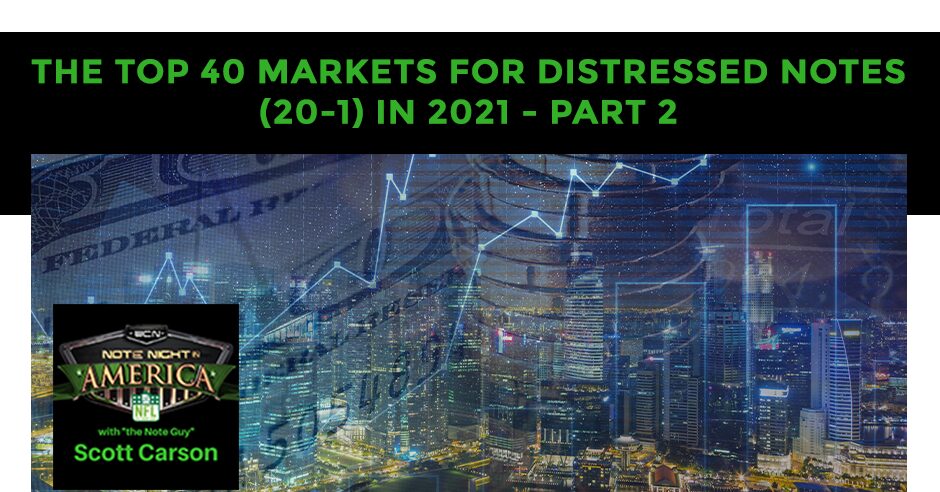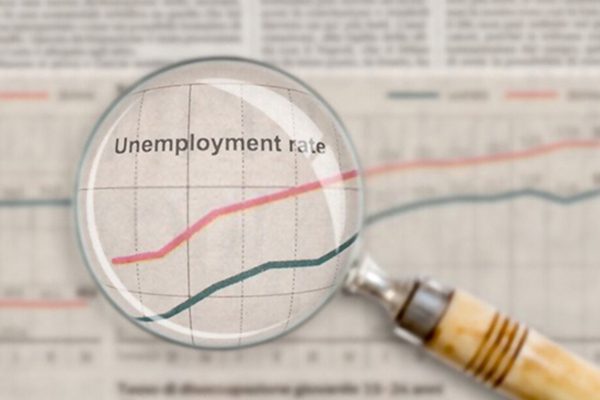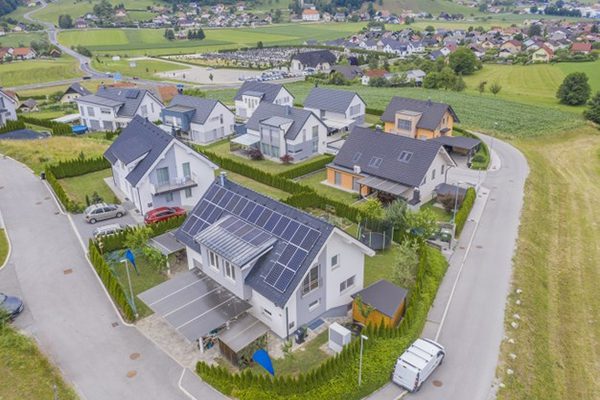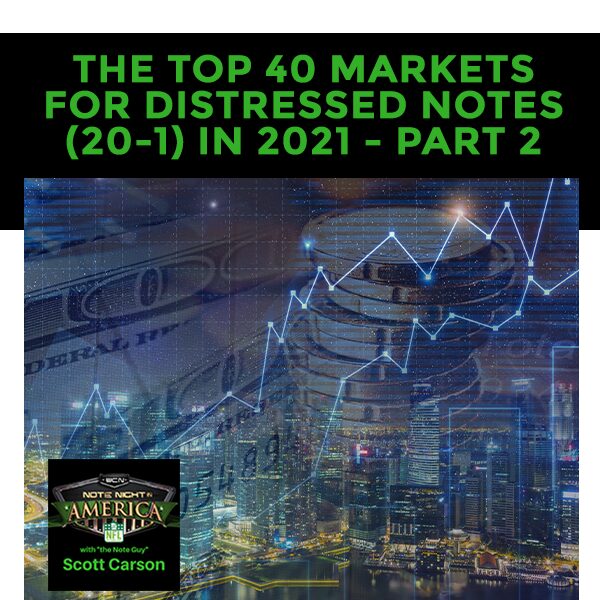
Are you excited for more of the Top 40 markets for distressed notes? Host Scott Carson breaks down the second half of the list. Listen to this episode as Scott explains how foreclosures, unemployment rates, and vacancy rates present opportunities for you to invest. The key is to spend time looking at each city. For example, Alabama has emergency rental assistance programs that can give you payments for your rents or your mortgages. If you want to find out more opportunities for investments in the Top 40 markets, this episode’s for you. So don’t forget to tune in!
—
Watch the episode here
Listen to the podcast here
The Top 40 Markets For Distressed Notes (20-1) In 2021 – Part 2
I’m honored to have you all here joining us. If this is your first time, welcome. We host this every Monday night, providing travel or vacation, or holidays. You can always catch the replays of all of our episodes by going to WeCloseNotes.tv, that’s our YouTube channel. It will give you the replays of all of our webinars, shows, and all of our other educational training videos on there as well. I always encourage you to check out our main website, WeCloseNotes.com.
I’m running across the country as the Note Guy. I’ve been buying debt for many years. I have been an active real estate investor since 2002. I’ve been buying debts since 2008. I am licking my chops on what’s going on in the industry. I purchased over $1 billion in distressed mortgages in that timeframe. I’m investing in roughly about 30 different states. I don’t invest in every state, but I know what’s going on most of the states and the different markets out there.
I’m the host of the nationally syndicated podcast, The Note Closers Show. Check it out, it would be a great thing. Lots of episodes, 680 episodes. The thing I’m most thankful for and most proud of is the fact that thousands of investors like you guys, no matter what your experience is, dive in to start investing and buying nonperforming notes. That is what our hope is to help you identify and find some opportunities for you.

Distressed Notes: People are making more than the cost of housing if it’s low affordability.
Let’s dive into the soap. This is the second part of this webinar. We’ve done the first part, from number 40 to 21. We’re going to talk about the top 20 markets out there as we rank them. By understanding where we’re at, you can look at the past. By the past, I’m not talking about going back many years ago. I’m talking about going back to the beginning of COVID, back in 2020. If you look at our peak numbers, roughly in March, April of 2020 versus our numbers now, unemployment was at a skyrocket 14.8% across the country.
It’s sitting at right about 6% last time I checked on the Bureau of Labor Statistics. A mortgage default rate peaked at 8.22% and it’s now 4.18%. It’s still half of what it was, but still about twice what it was before COVID kicked in. We had 2.4 million homeowners that were at least 90 days late, still sitting at 2.1 million homeowners. That number is not going down because of the fact that there were a lot of people already 30 days behind their mortgage before everything started.
Our numbers peaked at about 9%. All borrowers were in the forbearance agreement. We’re sitting at about 4.9% now. It gives you a bit of an idea of what’s going on in the mortgage markets and what’s affecting this stuff. We all know it’s a variety of different things for closure timeframes. There is not going to be a sudden huge wave of foreclosures across the country. We know that the government keeps kicking the can down the road, delaying foreclosures through executive orders.
Fannie and Freddie and all the government loans have decided, “We’re not going to start foreclosures.” That doesn’t mean it won’t start at some point. There are states already out there starting the foreclosure auctions on non-owner occupied or non-primary residence foreclosures taking place, entities, investment properties are already taking place.
One of the things that I like to track besides the foreclosure rate and default rates across the country are also unemployment rates because, as we know, if somebody is not able to work, been unemployed for a while, they’re going to make a decision either putting food on the table for the family, paying their utilities or paying their mortgage. 9 times out of 10, we know that paying a mortgage is not going to be the priority.
If you look at the unemployment rates of the top large metropolitan cities, these are the cities that have a million or more ranks out. With the national employment rate at 6%, what I chose to do is, “Let’s look at cities that have a higher than the government average of the unemployment rates.” That takes us to some of these cities. Some of these you’re not going to see on our list. Some of these you will see, some of these you saw on our first half. You can see some of these are some pretty decent cities.
What I have done also is I’ve taken other things. I’ve taken cities that had high vacancy rates and higher default rate, looked at unaffordability. What does that mean? Unaffordability, taking a look at an annual salary and comparing that to the average sales price in a city, and then given a percentage to see if it’s anything above 33% rate that way is a good thing because people are making more than the cost of housing.
If it’s a low affordability rate, that means the house is a lot more than what people are making in. Ideally, if you’re buying a house, you want your housing to cost no more than 38% of where you’re at. If you’re in that 30% range of your income, it would take three years of your salary to pay off your house. You’re roughly sitting pretty good, but other cities out there are not.
We’ve come up with this list of 40 cities. We’ll do a quick recap of the top twenty. How do we rank these cities? We look at percentage of homes that were 30 to 89 days late, and then 90 plus days late. That’s two separate rankings. We looked at another ranking of the vacant home percentage across these cities. We looked at the foreclosure rate prior to executive orders kicking in place. Forehand, it gives a bit of an idea if it’s going to peak or fall. We looked at existing unemployment rates. We also look at home affordability, median income versus median home price.
We ranked these 40 cities that we pulled across different categories then reranked them by average across all categories. That’s how we came up with our 1 through 40. Now, we’re not focused on 40 to 21. We’re going to focus on 20 to 1, which is why you guys are tuning in here. What cities have the opportunities? You’re going to be surprised by these. There are no cities in California on this list. 1 through 40, no California cities. That’s not a surprise to me. I’m very surprised there were several cities in Texas. That shocked my mind being here in Texas and seeing how the economy is doing.
Quick rank, 40 was Topeka. 39 was Cedar Rapids, Iowa. 38 was Jacksonville, Florida. Louisville, Kentucky with 37. Clearwater, Florida, was 36. Hampton, Virginia, was 35. Tulsa, Oklahoma, was 34. Winston-Salem was 33. Hartford, Connecticut, was 32. Birmingham, Alabama, 31. Killeen, Texas, which is where Fort Hood is, is 30. 29 was Amarillo, Texas. Atlanta, Georgia, surprised to make the list of the top 40 came in at 28.

Distressed Notes: Augusta, Georgia has a high unemployment rate of 8.3% compared to the 6% national average.
Orlando, I’m not surprised. The amount of unemployment that I’ve been seen came at 27. Memphis, Tennessee, 26. Little Rock, Arkansas, 25. I grew up in Corpus Christi, Texas, down on the coast, it came at 24. Baltimore, Maryland, 23. Newark, New Jersey at 22. Miami, Florida, came at 21. You might be surprised that Miami came in there because of a lot of growth, but they have a lot of defaults.
As we roll into the top twenty here, I wanted to make sure to ask, are there any questions? Court asked a good question, “What resources are you using to determine the list?” I’m pulling the list of Bureau Labor Statistics. I’m looking at default rates across the country, vacancy factors, and home affordability. This is my sheet. Total housing units, homeowner vacancy rate factors, 30 to 89-day late, 90 plus days delinquent rates, total percentage behind across the board, foreclosure rates, unemployment rates, household income and median income, then we reranked them all together. That’s how we came up with that 40.
There was a list pulled out of these top 40 cities and I didn’t like ranking them because I didn’t think it took affordability and some other things in general. What we’ve done is reranked these to help us come up with a better list for you. Each market’s going to vary. Foreclosure timeframes will vary. We’ve even done it a little bit differently to take a look at what programs, if they are available or if they’ve started foreclosure. I believe based on everything I’ve seen and my history is that these 40 cities are going to be some of the better ones to target if you’re looking for deals that make sense.
We’re not talking million-dollar markets. There are 1 or 2 markets on there with some higher price, real estate. You have to know inside of these cities. There are maybe some opportunities. Some of it maybe a little bit longer to get, which means if it’s a longer foreclosure process, it’s going to be cheaper getting the debt like it was beforehand.
Augusta, Georgia
Coming at number twenty, Augusta, Georgia came at number twenty in our list. Here are the numbers behind it. There were 87,000, 88,000 housing units in Augusta. 4.3% of the households are behind, at least 30 to 90 days. Somewhere in there, they’re least that many months behind. Before COVID, they had 1 out of 2,879 homes in foreclosure. It was the third highest on the list as far as the numbers.
It does have a nice home affordability, 32.1%, which is not bad. It’s an affordable area. It ranked an average at twenty across the different categories. The median home price, very affordable at $132,000. Out of the 87,000 to 88,000, 3.9% of the houses are vacant, out of state owners. People that have it as a second home.
In Georgia, it’s a relatively faster foreclosure state, 1 or 3 months foreclosed. There’s no protection besides the government, the federal protection. Georgia does have a Rental Assistance Program, which will give you up to potentially fifteen months of rent and mortgage payments if your borrower or tenant is available for it. That’s why I like it. It’s got some incentives for you. It could be a possibility for you to put in place.
Pittsburgh, Pennsylvania
Number nineteen, Pittsburgh, Pennsylvania, Steel City. One hundred fifty-nine thousand units about twice the size of Augusta. 3.8% of the households are behind. One of every 5,000 homes was roughly in foreclosure beforehand. It’s got a little bit lower affordably rate at 24.2%. It ranked the average at twenty crosses different categories, median home price of $201,000, 1.5% are vacant. It’s got a high unemployment rate, 8.3%, compared to the national average, 6%. That’s why we’re going to see more defaults in this city than in others.
When you already see that households are behind and unemployment is still high, that’s when it calls for more opportunity. It takes about 4 to 12 months to foreclose. Judicial foreclosure. There’s not any protection besides the federal stuff. There are some rental assistance programs in the State of Pennsylvania that are available. They released another $400 million in potential assistance for rental assistance programs for your tenants, your borrowers, your under-financed stuff or things like that. It would be available. Check it out.
San Antonio, Texas
This surprised me. Number eighteen was San Antonio, Texas. This was probably one of the biggest surprises on the list. I live in Austin, Texas, and it’s different. San Antonio, Texas, 561,000 housing, that’s a pretty good size. That’s not the number of people. That’s the number of housing units, 4.6% of those households are behind. It was 1 of every 8,100 homes that were in foreclosure before COVID. It’s got a 25.5% home affordability rate. Ranked at an average of twenty across the rest of the different categories. The median home price is $206,000 and 3.4% of the total housing use are vacant.
To give you a bit of an idea, that’s half of what it is here in Austin. The median home price is right over $414,000 or $415,000 in Austin, Texas. A lot of Austin investors have been flocking to San Antonio, Texas, but San Antonio does have some issues. It is faster foreclosure. There’s no protection here in this state. The state hasn’t started filing foreclosures yet. There’s no federal protection beyond the state. It does have a bit of a higher unemployment rate, 6.8%. You’re going to see some opportunities there.
Texas does have a $1 billion Texas Rent Relief fund that was put in place that you could happen to and go from there. It’s an opportunity to work with your borrowers, tenants, and stuff like that. We’ve seen opportunities. We’ve seen more distressed debt in San Antonio than we’ve ever seen in Austin. That goes back many years. Occasionally, I see something in Austin. I’ll see some stuff more often in San Antonio than I’ll see here.
Norfolk, Virginia
Number seventeen is Norfolk, Virginia, home of the Navy shipyards. Norfolk, less than 100,000 housing units, 3.7% of those are behind. One in every 5,000 homes is in foreclosure prior to COVID. It’s got a 22.6% home affordability, where the pricing of homes is outpacing the median income a little bit. Median home price of $229,000, 3.4% of households are vacant. The unemployment rate is a little bit of a national average of 6.2% in Virginia. It’s a nonjudicial foreclosure state, four months to foreclose.
The foreclosure protection is set in place by the governor stops 90 days after the state of emergency for Virginia ends. Something to keep that in mind. There is a program called Stay Home Virginia, which does give you borrower and tenant assistance programs. That’s part of what I looked into these cities and states in the long case cases like, “Do I see opportunity there? Yes.” Not like the hardest hit funds that used to be around, but there are some programs in place that you may want to take advantage of. There’s also a $524 million allocated to the Virginia Rent Relief Program that came out in February of 2021.

Distressed Notes: Alabama has emergency rental assistance programs that can give you payments for your rents or mortgages.
Syracuse, New York
Moving on to number sixteen, Syracuse, New York. Somebody was like, “Scott, why would you say New York? You also had Newark on last time we did it.” If you live in New York or New Jersey, there are some opportunities. Yes, it’s a longer foreclosure timeframe, but not everybody that you buy the debt on is going to drag out to foreclosure. There are a lot of opportunities there if you know where to look and if you live locally.
Syracuse is a little smaller city, with 72,000 housing units, 3.8% of households behind. For foreclosure, 1 in every 9,500 homes. It’s got an affordability rate of 22.6%. It ranked an average with twenty across categories. Median home price of $138,000, which I liked, which means pretty affordable. It had a high vacancy rate of 5.2%. Part of that is because of the university that’s there. The unemployment rate was also higher at 7.3%. Those two numbers lead to some opportunities. As they say, fifteen plus months to foreclose, this could take you two years of foreclose. Foreclosures have resumed.
It started back up a little bit there in the New York State. There are foreclosure and tenant assistance programs available for you. If you got a bar in place that wants to stay and is willing to work with you, you may be able to tap in some of these government programs and turn nonperforming notes into performing notes. It’ll come out pretty good. The median home price is $138,000. That’s why it’s a much more desirable market than New York City or Brooklyn. You’ve got some major employers in the neck of the woods.
El Paso, Texas
El Paso came at number fifteen, the city that we don’t include in Texas. El Paso, Texas, has its time zone. It’s not Central standard time in El Paso, but El Paso made the list. El Paso’s 250,000, pretty good size market. 5.6% of households are behind, which leads to opportunity. 1 out of every 6,200 homes was in foreclosure. It’s got a little bit higher home affordability rate, 30.7%. Median home price is $155,000, which is pretty affordable. It had number one vacancy rate compared to the other 39 cities, almost 10% of the homes were vacant.
It does take fast foreclosure because it is still in Texas. 6.8% unemployment rate is a little higher than the national average. The unemployment and vacancies are kicking in. We do have that $1 billion Text Rent Relief fund that you can use if you’re in Texas to help you collect or help your tenants get back on track. I was very surprised, not only about San Antonio, but El Paso. It’s a little bit more affordable, but it is a good-sized city.
Why the vacancies? It’s because you do have people coming across the border. You do have some Mexican nationals that live in El Paso. You’ll see that in some of the border cities as well too. It’s an opportunity for you to pick up some houses pretty relatively cheap. You can foreclose and quickly make some nice change.
Miami Beach, Florida
Number fourteen was a surprise. Number 21 on the list was Miami. Number fourteen is Miami Beach. They are separate, not the same. Different demographics. To give you an idea on Miami Beach, it is 66,000 units, 3.4% of the households there are behind. One out of every 6,100 homes were in foreclosure. Third lowest affordability rate, 14.1% home affordability. It means the incomes based on the value is not good. Median home price in Miami Beach, you’ve got some million-dollar condos that are dragging things out, it’s $384,000.
It’s the highest vacancy rate out of the 40, 8.7%. You got some vacant nonperforming condos and homes in the neck of the woods. There’s going to be some opportunity there. We’ve already found some stuff in the neck of the woods. Keep looking at stuff. Florida is a judicial foreclosure state. There are foreclosed starting back up. It does take you about 8 to 14 months to foreclose. You may be able to pick up some assets though, where the bank has already started the foreclosure process and be able to step into those shoes.
If it’s vacant property, a lot of times, the courts will accelerate or you can work with a bar or still walk away if it’s a vacant property. There is a large portfolio of money, $850 million in Florida rental assistance. This is for cities with 200,000 or more individuals. Miami Beach falls in that line. We keep in mind with that is that there is still a little bit higher unemployment rate compared to the national average, 6.3%. There is a lot of money out there for the largest cities in Florida, Miami Beach being one of those separately from Miami.
Mobile, Alabama
Mobile, Alabama, came in at thirteen. This was a little bit of surprise. I’ve been through there a few times. There are 93,000 housing units. 5.4% of households are behind, though. That was a higher number than average. One out of every 8,800 homes was in foreclosure prior to COVID. It has about a 30% home affordability rate. Median home price of $142,000. Two to three months to foreclose. It’s nonjudicial, no protection for the most part.
This is what I like about Alabama. Alabama has some emergency rental assistance programs that can give you payments for your rents or your mortgages, past payments, current present, and then three plus in the future. Opportunity picks up somewhere around 6 to 7 months of back payments if you step in and can get the borrower or the tenants to work with you.
Columbus, Ohio
In our top twelve, the Columbus that many people forget about. Not Columbus, Ohio, but Columbus, Georgia, Steph’s hometown, where she grew up. The more I see about Columbus, the more I hear about Columbus. The more I look into it, the more I get excited about Georgia, everybody gets excited about when you think about Georgia like Atlanta.
Columbus is an opportunity. If they know about it, you want to take pay attention to Columbus, Georgia. Eighty five thousand housing units, 4.7% of households behind, on average. One of every 4,000 homes was in foreclosure prior to COVID. 38.8% home affordability rates, third highest on the list. That means people are making some money and the homes are affordable there. The median home price is $120,000, but it does have 3% vacancies across the board, which is starting to get up.
You want to stray that 1% or below that. It’s got some vacant homes. Part of that is due to the fact that it is not too far from Fort Benning, the military base that’s there. Columbus is on the border of Alabama. You get a lot of people moving back and forth. Georgia, a fast foreclosure state. There is a Georgia Rental Assistance Program for fifteen months.
Macon, Georgia
Another state, Macon, Georgia. I’ve been through there. I liked the area. There are 70,000 housing units, 6.2% of the households are behind, at least 30 to 90 days. That’s the fourth highest on the list. One in every 6,200 homes was in foreclosure prior to COVID. It has great home affordability. Second highest of the list of 48.4%. It means the average income is 48% of what the annual cost is.
The median home price is $100,000. This is one of the most affordable cities out there. The low vacancy rate is at 1.9%, 5% unemployment, it fell below the national average. The point I’m trying to get at here, the fast foreclosures, it does have some stuff coming down the road here. It does have a higher percentage of people being behind.
This is a great opportunity, especially with the median price being $100,000. You can pick up some great properties and possibly tap into the Georgia Rental Assistance Program and some of the federal government plans. You can buy some debt in the neck of the woods, or look for houses in that neck of the woods where the rent rates are pretty good.
Springfield, Massachusetts

Distressed Notes: In Columbus, Georgia, one of every 4,000 homes was in foreclosure before COVID.
Number ten takes us up North, which was surprising, Springfield, Massachusetts. The numbers that popped up in Springfield, 60,000 housing units, 4.5% of the households are behind. One of every 7,300 homes was in foreclosure before COVID and a low affordability rate. This is what is going to be driving a lot of the defaults there.
Laura, you still need to be licensed to buy in Georgia or fund with your self-directed IRAs, the one exception. With Springfield, 19.1% of home affordability rate. This is one of lower home affordability rates, starting below at 25%. Ranked average of 24th across categories. Median home price is $204,000. Average income is roughly right around $40,000, that’s why it was set at 19.1%. 1.8% vacancies, high unemployment rate of 8.3%. This is what you’re going to see. People are losing their jobs, staying unemployed, and they can’t afford the payments.
That’s why you’re going to see a lot of opportunity in there. This takes roughly three plus months to foreclose. Nonjudicial foreclosure in Massachusetts. You can’t start foreclosure until 120 days after the COVID emergency goes out. There are several programs in Massachusetts. You have the Emergency Rentals Assistance Program, ERAP. You’ve got the RAFT, Residential Assistance for Families in Transition, and Emergency Rental and Mortgage Assistance or ERMA. ERAP, RAFT and ERMA are three big programs in Massachusetts. That federal one is available at all across the states, but there’s a lot of money out there for you if you buy debt, maybe potentially work with the homeowners in place to keep them in or your tenants.
Brownsville, Texas
We go South to the border, Brownsville, Texas. This is why I’m surprised, there were six Texas cities that made the top 40, which is a rarity. Brownsville, Texas, along the border, 60,000 housing units, there are 7% of houses behind. This was the second highest. One of every 20,000 homes were in foreclosure prior to COVID. This one the big thing. Brownsville is a boomtown. Many houses are getting built.
People come across buying houses, but they’re behind. It has a pretty good home affordability rate. Median home price is $119,000. It’s pretty affordable compared to other parts of the state like San Antonio, Texas, Dallas, Houston. 1.7% of homes are vacant, fast foreclosure. This is the kicker, 10.9% unemployment rates.
The second highest on this list. When you have a high number of houses behind and a high unemployment rate, it’s going to lead to opportunity if you know where to look. If you want to tap into the $1 billion for the Texas Rent Relief fund, it’s a possibility for you. Keep your eye out on the border towns. I should be taking a trip down to Brownsville shortly to take a look at it.
Jackson, Mississippi
Jackson is number eight on the list. Jackson, Mississippi, not Jackson, Michigan. The largest city in Mississippi and the only city in Mississippi that has over 100,000 people population. There are 75,000 housing units. 6.1% of those households are behind. It’s the fourth highest off the list of 40 here. One in every 4,400 homes were in foreclosure prior to COVID. Most affordable city on this list with 69% home affordability rate. It ranked good. The median home price in Jackson, Mississippi is $56,000.
When you compare that to the rent rates, it’s a great city to buy some real estate with 2.5% vacancies. Our friend Walter Woolford lived there for years. He loves it. It’s a nonjudicial four months to foreclosure. Works in your neck of the woods, you’re taking property back. There’s not any protection besides the federal stuff. There are no state programs that help people behind in Mississippi.
Most affordability, if you’ve seen homes at $56,000 and you’re picking them up at $20,000, $28,000, you need a little work and you put somebody in there, this can be a goldmine for you. Jackson, Mississippi, while it’s number eight, it may become one of my top 5 or 6 cities to look at here. Pay special attention to that.
Lafayette, Louisiana
Lafayette, Louisiana, we get into the gumbos state. No surprise here, 59,000 housing. It’s about the same size as Jackson. 4.9% of the houses are behind, tenth highest on the list. One in every 5,400 homes were in foreclosure prior to COVID. They had a pretty good affordability rate of 28.3%. Median home price is $181,000 with 2.4% of all households being vacant. You got nine months to foreclose. It’s judicial, not in protection. There are some rental relief programs that went into play in March of 2021. This was surprising, 5.6% unemployment, a little bit lower than the national average. The affordability is nice and there are people behind. It’s almost a direct correlation between the unemployment rate and the houses behind. University of Louisiana at Lafayette is one of the major employers there. As they get back to normal, it’ll be a great place for you to be investing on there.
Philadelphia, Pennsylvania
We jump North to City of Brotherly Love. This was a surprise, Philadelphia making my list at number six. It’s one of the largest cities on this list, 692,000 units. I had a realtor argue with me about the numbers. I was like, “Numbers don’t lie.” 4.1% of households were behind, at least 30 to 90 days. That’s an opportunity right there. 4.1% of 700,000, that’s 28,000 households. One of every 3,600 were in foreclosure. The price values around the Philadelphia area are going up faster than income.
The affordability rate is 21.9%. Median home price, $210,000, 1.1% vacancies. Low vacancy rate because people are gobbling up homes and moving there and try to move up. It’s judicial foreclosure for twelve months foreclose. There are no state protections in place. There are some rental relief programs. This is the biggest kicker, the 11.2% unemployment rate was the highest on the list.
You have households behind, people are unemployed, people are gobbling up houses when they go into default. There are still going to be a lot of opportunities because people will drag stuff out in forbearance agreements or they’ll get dragged out because they can get kicked down the road. If you want to be an Eagles fan, you want to invest in Philadelphia. Pittsburgh and Philadelphia are both in the top twenty. Pennsylvania is one of those states you want to pay attention to, especially around those two major metroplexes.
Laredo, Texas
Number five, Laredo, another city down the border town. I was surprised that the images I found were not like empty streets, but it was some of the better-looking photos that I can find. This surprised me, 80,000 housing units. It’s on par with roughly what Brownsville is, 10.2% of households behind. This is the highest on the list. People haven’t paid their mortgage and they’re leaving. One in every 10,000 homes are in foreclosure prior to COVID. It’s a big change with those taking place. Under 29.5% home affordability rate. Median home price is $162,000, 8.7% vacant homes.
People living across the border in Mexico left their houses vacant. There are lots of opportunities to buy some vacant homes from banks. Fast foreclosure. 8.6% unemployment rate, it’s almost 50% higher than the national average. This is why Laredo is a top five city. There are still people looking to buy. There are some vacancies, but an opportunity for you to come in and buy up some property that will rebound once things hit rock and rolling.
Shreveport, Louisiana
Number four takes us back to Louisiana to Shreveport. Shreveport, with 91,000 housing units, 5.2% of the households were behind, the eighth highest on the list. Before COVID, 1 out of 3,100 homes was in foreclosure. It’s got a decent affordability rate of 33.7%. Median home price of $116,000. This is a nice affordability area, 2.1% vacant factors. It’s a little bit higher than where you want to be at, but not nearly as high as the other cities out there.
Louisiana is a judicial foreclosure state, no protections in place beyond the federal government stuff. 6 to 9 months to foreclose. There are rental relief programs for the whole State of Louisiana. It does have a 6.8% higher unemployment rate, which is higher by almost 1% of the national average. Almost directly related to the houses behind equal to the unemployment rate. No surprise there.
Fayetteville, North Carolina
Fayetteville, North Carolina, this surprised me. North Carolina has been a booming state for a while. I’ve bought in North Carolina for years. Fayetteville is blooming in a lot of ways, but it’s an opportunity for us as investors. Ninety four thousand housing units, 4.7% of those houses are behind. One out of 5,000 homes was in foreclosure. Decent home affordability rate, 31.7%. Median home price is $142,000, 2.1% vacancies. It’s not the lowest vacancy factor, but it still got affordable homes compared to some other parts of North Carolina.
It’s nonjudicial. You’re starting to see some foreclosures starting to pop back up that aren’t covered by the executive orders and the federal. The state does offer eviction avoidance programs. You want to check on a city-by-city, state-by-state level. They have a high unemployment rate, 7.8%. These unemployment rates are falling primarily in that sub $200,000 home price. That’s most of the median home price of $142,000 that first time home buyers were thinking they’ve got a lot of opportunities to step in and pick up some assets. Faster foreclosure state, North Carolina is a great state to invest in.
Baton Rogue, Louisiana
It’s not rural. Fayetteville has about 250,000 people, if not more. There’s an opportunity in North Carolina. Keep an eye out for Fayetteville. Number two, Baton Rouge, Louisiana. One hundred four thousand housing units, 6.2% of the houses are behind. It’s the fourth highest on the list. One out of every 8,700 homes was in foreclosure prior to COVID. Lower affordability rate compared to other parts of the state, 23.3% home affordability.
Median home price, $191,000, a little bit higher than the previous ones. 2.4% vacancies. 6 to 9 months to foreclose, no protection. There are some rental relief programs put in place in March 2021. It has a 6.2% unemployment rate. It is exactly right on track with the number of households behind. If you like Louisiana, there you go. Shreveport, Baton Rouge, Lafayette.
New Orleans, Louisiana
Our number one city on the list, The Big Easy, New Orleans, Louisiana. We all know Louisiana has been hit very hard by COVID, which caused a lot of why in the state is making the top off the list. New Orleans, 192,000 housing units, 5% of the households behind. That’s only the eighth highest scores behind compared to the rest of the country. One in every 5,100 homes were foreclosed prior to. It has a low affordability rate, fourth lowest, 17.2%.
When you look at the median home price in New Orleans, it’s $241,000. A lot of that is dictated by what’s going on down in Bourbon Street in that neck of the woods. New Orleans itself obviously has been hit hard with hurricanes or anything happened, Katrina and Rita, stuff like that. People have not recovered yet. Fast to foreclose, 6 to 9 months, not like the 1 to 2 or 1 to 3, but still some opportunity. There is no protection in place. There are rental relief programs. It has an 8.6% unemployment rate, fourth highest.
This falls in line with a lot of the service industry, the bars, restaurants, and stuff like that. There’s an opportunity if you want to own something in New Orleans and a few other cities along the Gulf Coast. That’s no surprise that a lot of these have poor areas in them. The high-end cities didn’t make the list. I’m not surprised there. These top 40 cities are where you’re going to see the biggest bang for your buck. What worked here to talk about obviously is your ROI, Return On Investment, and your ROT, Return On Time. Know your markets and know where the opportunities are at.

Distressed Notes: Unemployment rate means opportunity. You have to spend time and look at each city.
I want to open up for questions. Are there any questions on the top twenty cities that we talked about? David asked a good question, “What is your take on unemployment rates? Is it better to invest in cities with high or low unemployment?” Here’s what you have to do when you’re looking at the unemployment rate. Unemployment rate means opportunity. You have to spend the time and look at each city. I’ll give you an example. Unemployment rates in Miami come a lot from tourism, or in Orlando, the theme parks.
People have been laid off. They’re still aren’t coming back in full-time. You need to know what’s going on in each city and what’s going on in that market. It helps you identify to track the cities with high unemployment rates where it has the most amount of opportunity. It’s up to you what you want to focus on in the cities.
Jessica asked a good question, “Is there an average cost for foreclosures, nonjudicial and judicial?” It will vary on a state-by-state basis. It can be as cheap as $1,000 to $1,500 here in Texas, all the way up to like $10,000 in New York State. When I’m running numbers, I’ll put an average of roughly $2,500 for nonjudicial.
That’s just the foreclosure. The average is roughly around $4,000 to $5,000 for the judicial foreclosure, the longer timeframe. New York, New Jersey, I put $10,000 if I’m going to buy there, but I’m not buying there for the most part. The thing to keep in mind, if you’re buying a longer foreclosure state, that should help you get a cheaper discount from the bank and the lenders because it is a longer foreclosure judicial state.
David, “When you found these 40 cities, how many cities did they come out from?” As many cities there are in the United States, they’re saying like Southern California, San Diego, 30% of the bars are at least 90 days behind, but it’s such a delay to foreclose there. Banks aren’t selling that stuff at a price that makes sense. I wanted to focus on cities that I thought you guys would have opportunities in.
Wayne says, “Not any in Central upper-Midwest states?” Yes, I was surprised about that, not much up the neck of the woods. What I found, if you look at the poor states, Alabama, Mississippi, Jackson, Louisiana, that’s where it fell into a lot of the stuff. “Which websites do you use to scan these properties?” I would use NoteProz. You can use a variety of different things. Some people are using PropStream. We use NoteProz to pull some numbers fast. Buying debt, you got to look at the information on the note, the debt, the mortgage, the bar, and the properties. It’s not just all about the properties.
Charles asked a good question, “Do I use LinkedIn and reach out to bankers in these markets or source these markets online, like props and foreclosures and then reach out?” You could do 1 of 2 things, Charles. I would go back and look at our episode where we talked about using the foreclosure list identified banks. You jump on Foreclosures.com or the foreclosure listing service of any of those states or those counties that you like. Look at the banks they have, get in contact with the banks either on LinkedIn or call them directly.
Norman asks a question here, “Can I recap the affordability calculation?” Yes. What I did to calculate the home affordability was take the median home price on the bottom and I took the median average income. If the average median income in that city is $40,000, I divide that by the average home price that was $160,000. That would be a 25% affordability rate. The higher the affordability rate, the better. The lower the affordability rate, bad. It means that people are making enough money on average to afford the housing there. Median income divided by median home price. You want that percentage to be high.
You don’t want it to be low. If it’s low, like 10%, say Mason’s making $40,000 and the median home price is $400,000. That’s not a good relationship. You want it to roughly be in that 30%, 33% range even higher at 40% to be more affordable for places. We will wrap it up. Thank you so much for joining us here. I highly recommend you go back and check out the first part of this, the numbers 40 through 21. Thanks, everybody. Be safe out there and we’ll see you all at the top everybody. Bye.
Important Links
- WeCloseNotes.tv – YouTube
- NoteProz
- PropStream
- Foreclosures.com
Love the show? Subscribe, rate, review, and share!

